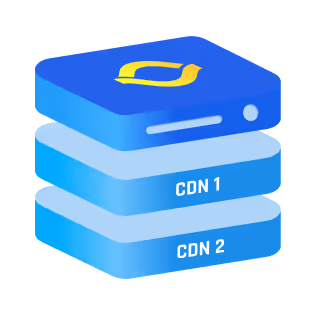If you’re diving into how websites work, or just trying to understand what powers the internet behind the scenes, you’ll eventually come across the term DNS AAAA record.
It sounds technical, and it is, but once you break it down, it’s simple. Think of it as a phone book entry for the internet, but for IPv6 addresses. Here’s what we mean:
What Is a DNS AAAA Record?
A DNS AAAA record (pronounced "quad-A") maps a domain name to an IPv6 address. That’s it. Whenever someone types in your website’s domain, the DNS (Domain Name System) checks the AAAA record to figure out what IPv6 address to send them to.
Here’s the key:
- A DNS A record maps domain names to IPv4 addresses (e.g., 192.0.2.1)
- A DNS AAAA record maps domain names to IPv6 addresses (e.g., 2001:0db8:85a3:0000:0000:8a2e:0370:7334)
In short, AAAA = IPv6.
{{cool-component}}
Why Use an AAAA Record?
You only need a DNS AAAA record if your website or server supports IPv6 networking.
That means you’re ready for the modern internet, which has moved beyond the older IPv4 system due to the shortage of IPv4 addresses.
Here’s why an AAAA record matters:
- IPv6 is the future. The internet is running out of IPv4 addresses.
- Better performance in some regions. Some networks prioritize IPv6.
- Essential for mobile and IoT devices. These often connect over IPv6 by default.
- Dual-stack readiness. You can run both A and AAAA records for maximum compatibility.
How AAAA Records Work (Step-by-Step)
Let’s break it down into a real-world scenario:
- User types in a domain like example.com.
- Their device asks the DNS system: “Hey, where is example.com?”
- The DNS server responds with:
- An A record if the site is using IPv4.
- An AAAA record if the site is using IPv6.
- The browser connects to the returned IP, loads the site.
That lookup is called an AAAA record lookup. You can test it yourself using tools like dig, nslookup, or online DNS checkers.
Example command: dig AAAA example.com
You’ll see the IPv6 address if there’s an AAAA record set.
Difference Between A and AAAA Records
If your site supports both protocols, you should set both A and AAAA records. That way, you’re not locking out any users.
AAAA in Networking
You’ll find AAAA records used in:
- Modern websites that want to support IPv6 clients
- CDN providers that serve traffic over IPv6
- ISPs and telecoms that prioritize IPv6 to reduce NAT overhead
- Cloud platforms like AWS, GCP, and Azure
If you don’t add an AAAA record, IPv6-only clients might not reach your site. That’s especially common in mobile networks and newer countries rolling out fresh infrastructure.
How to Create a DNS AAAA Record
Here’s how you can add one:
- Log into your DNS provider (Cloudflare, GoDaddy, Namecheap, etc.)
- Go to your DNS settings or Zone Editor
- Click “Add Record”
- Choose AAAA as the record type
- Set:
- Name/Host = @ or your subdomain
- IPv6 Address = your server’s IPv6
- TTL = automatic or 300 seconds (5 minutes)
Click save, and you’re done. It can take a few minutes to propagate.
{{cool-component}}
How to Check an AAAA Record (AAAA Record Lookup)
If you want to test whether your domain has an AAAA record, here are your options:
- Using dig: dig AAAA yourdomain.com
- Using nslookup: nslookup -type=AAAA yourdomain.com
- Using an online tool: Sites like dnschecker.org or mxtoolbox.com let you do an AAAA record lookup from multiple locations.
Do You Need an AAAA Record?
Here’s a quick decision checklist:
If you only support IPv4, then skip it for now. But keep in mind: sooner or later, IPv6 will become essential.
Common Issues with AAAA Records
If things don’t work right after adding a DNS AAAA record, check for:
- No IPv6 support on your server: Adding a AAAA record doesn’t magically enable IPv6.
- Firewall blocks IPv6 traffic: Your site may be unreachable via IPv6.
- Incorrect TTL or propagation delay: Changes can take time to reflect.
- Mixed content issues: Your site should serve all content securely over both protocols.
Always test your site over IPv6 using a browser or ping tools like ping6 or curl -6.
AAAA Record Priority and DNS Resolution Order
So, what happens when your domain has both an A record (IPv4) and an AAAA record (IPv6)? Which one does a browser or device use first?
The short answer: it depends on the system and the network, but there’s a method to the madness.
How it works:
When someone visits your site, their device performs a DNS query for both:
- The AAAA record, to get an IPv6 address
- The A record, to get an IPv4 address
The operating system or browser then decides which IP to use.
This decision is based on a set of rules defined in RFC 6724, which prioritizes IP addresses based on reachability, latency, and administrative preference.
“Happy Eyeballs” (RFC 6555)
To avoid delays, modern browsers (like Chrome, Firefox, and Safari) use a technique called Happy Eyeballs.
Here’s what it does:
- It tries both IPv6 and IPv4 in parallel, and whichever responds faster, wins.
- This means AAAA isn’t always used first, even if it exists.
- It's a way to make IPv6 adoption seamless, without punishing users on flaky IPv6 networks.
Conclusion
A DNS AAAA record is your ticket into the IPv6 world. It helps your website reach more users, supports modern networks, and makes your infrastructure ready for the future of the web.
So if you’ve got an IPv6 address and a domain name, now you know exactly how to link them. All it takes is one little AAAA record.



.png)
.png)
.png)






